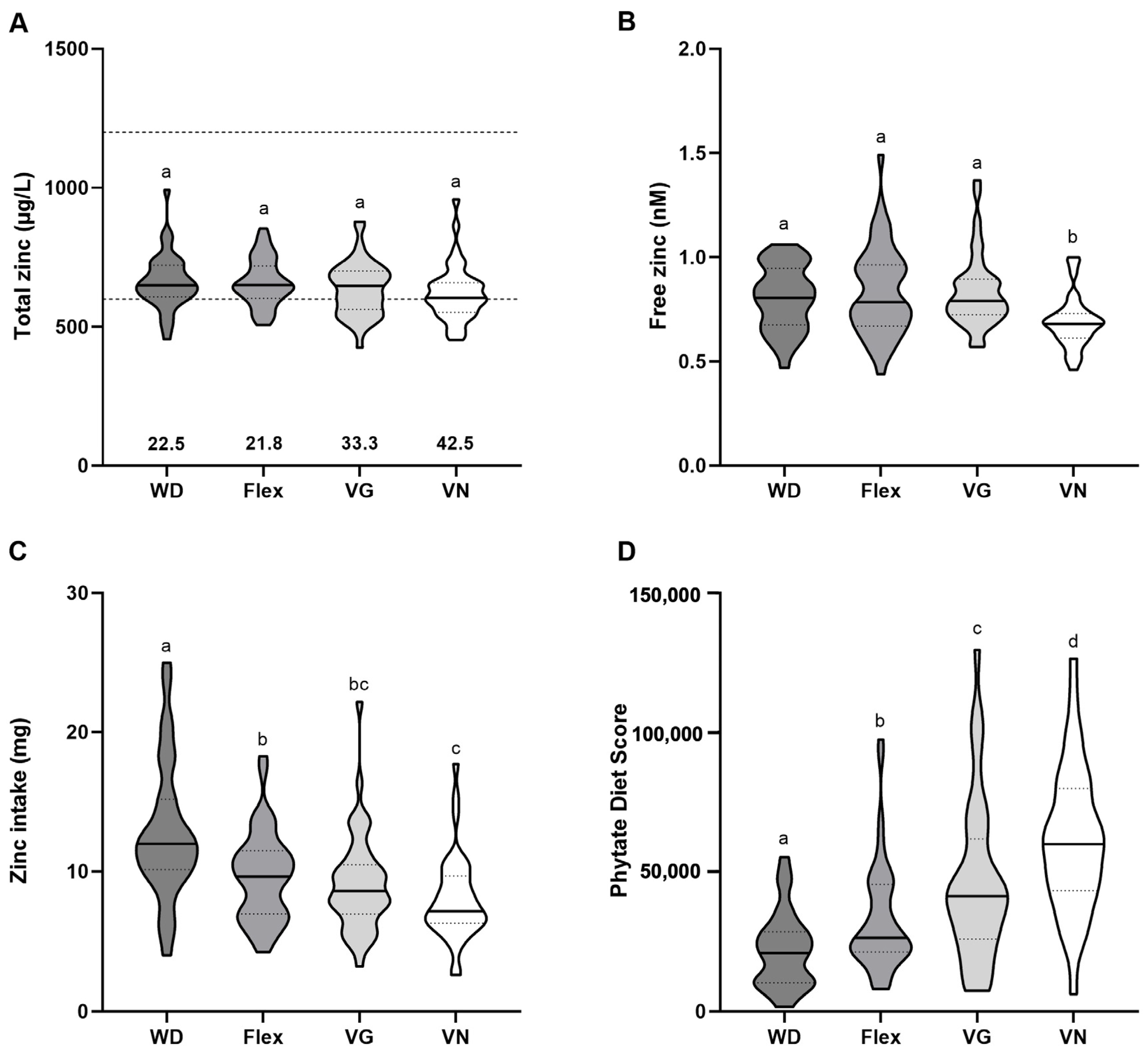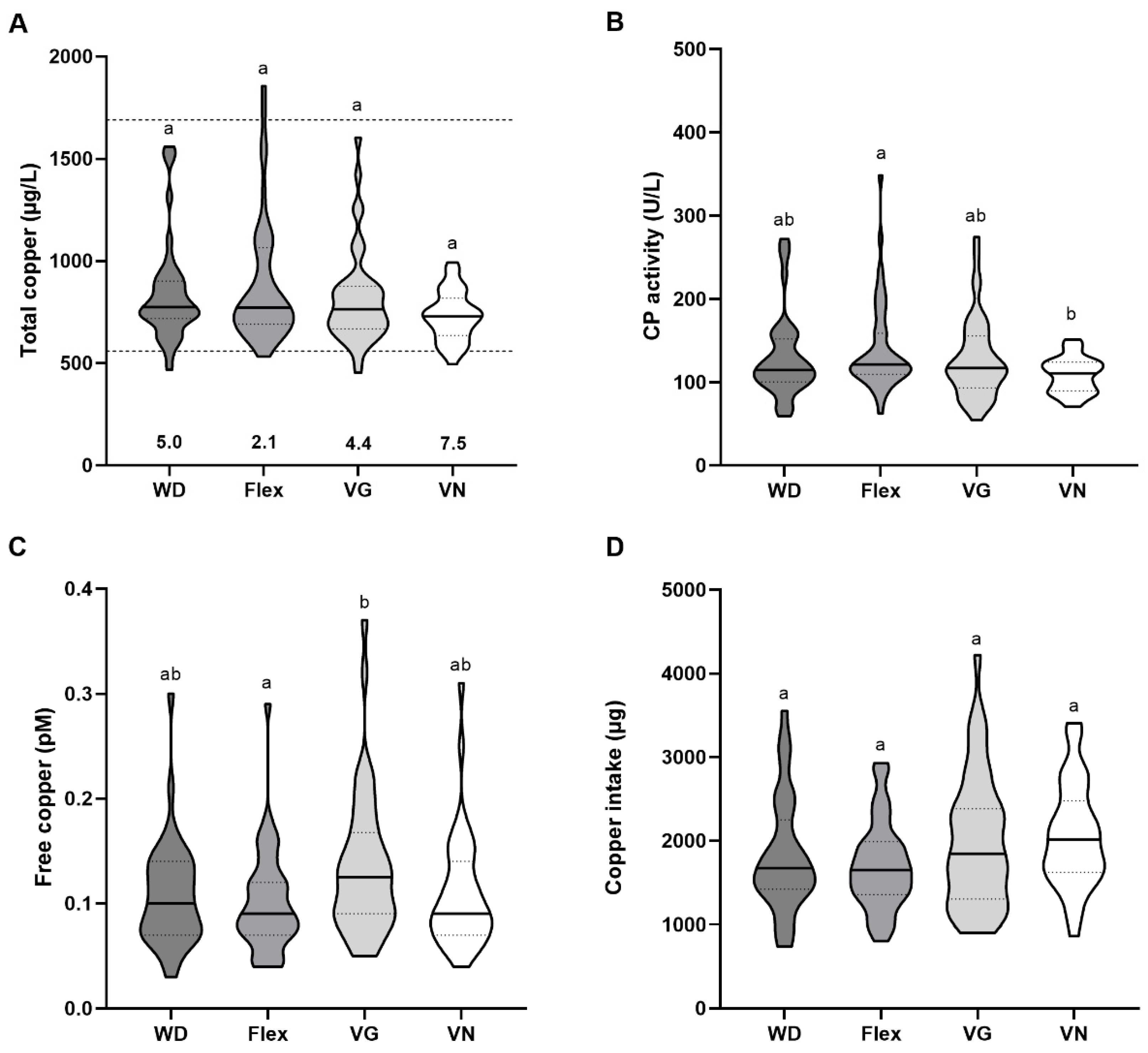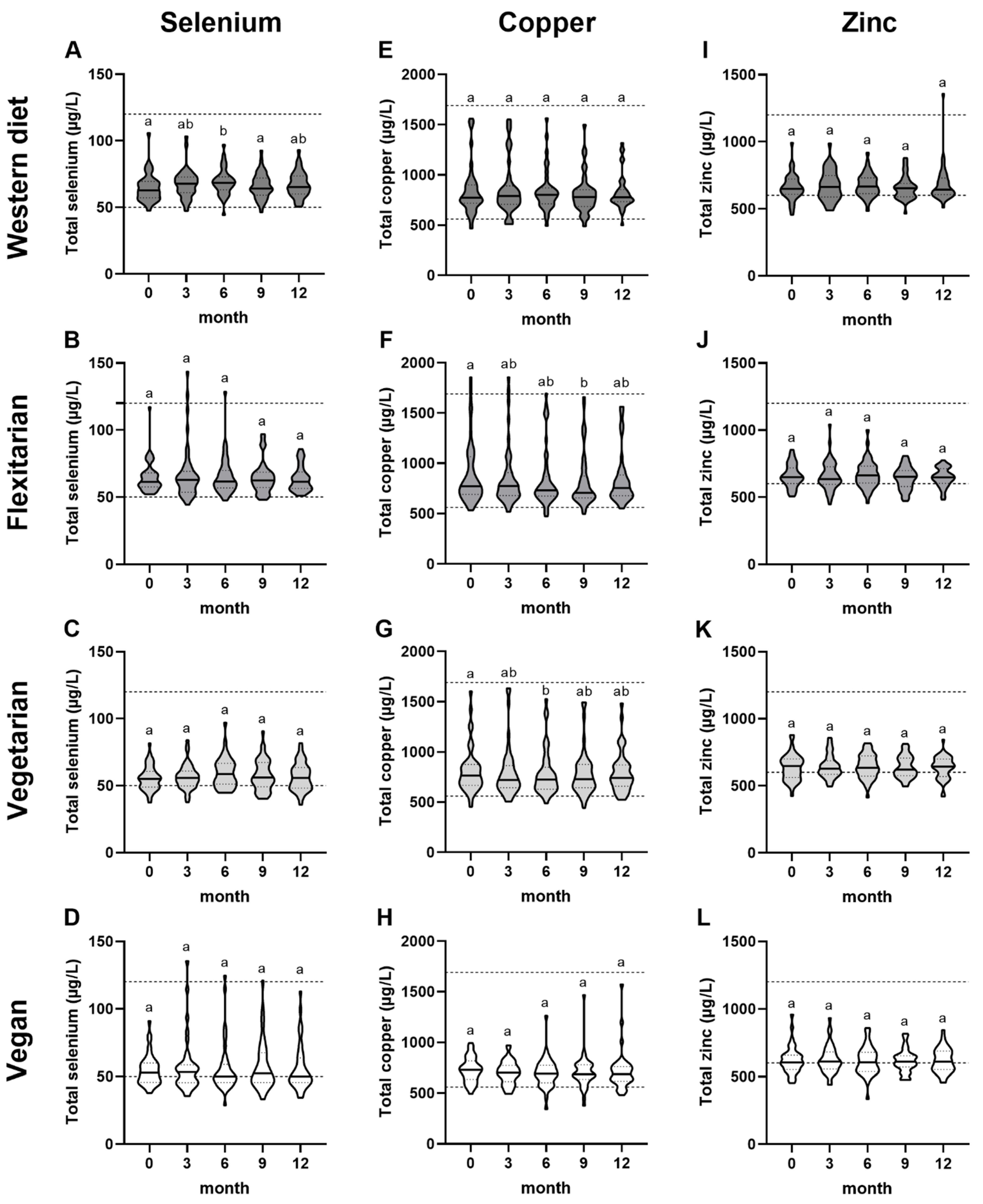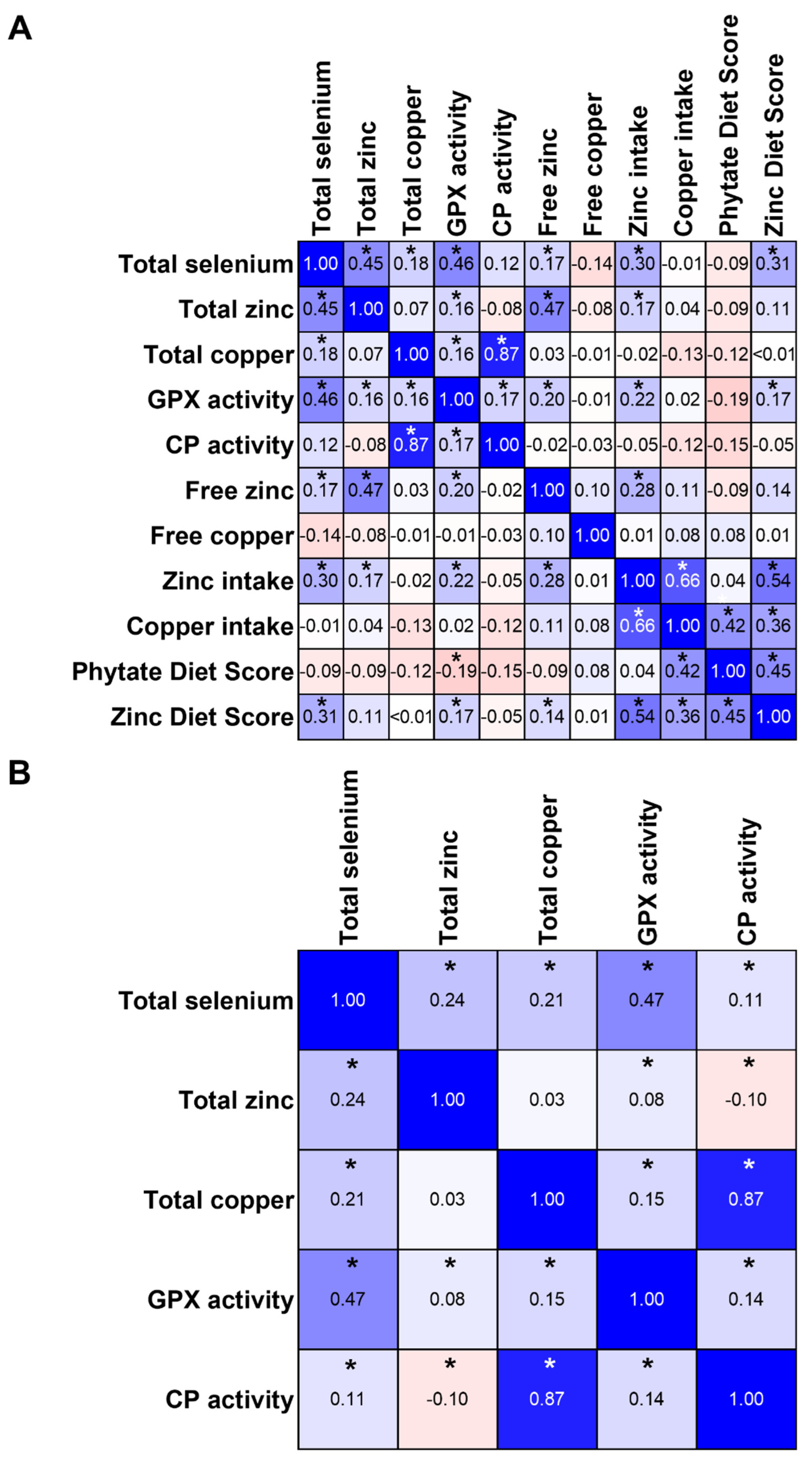Selenium, Zinc, and Copper Status of Vegetarians and Vegans in Comparison to Omnivores in the Nutritional Evaluation (NuEva) Study
Abstract
1. Introduction
2. Materials and Methods
2.1. Participants
2.2. Study Design and Diets
- Adequate amounts of energy derived from carbohydrates, protein, and fat in accordance with the guidelines of the German Society of Nutrition [25];
- Defined intake of saturated fatty acids (SFA, <10% of daily energy), monounsaturated fatty acids (MUFA, >10% of daily energy), PUFA (~10% of daily energy), and at least two grams of alpha-linolenic acid per day, e.g., through linseed oil (5–10 mL per day between study month 3 and 12);
- Encouraged consumption of vegetables, fruits, and cereals;
- Intake of >40 g dietary fiber per day based on the MoKaRi concept [26];
- Salt (maximum of 6 g per day) and sugar reduction (maximum of 50 g per day);
- Reduced intake of highly processed, calorie-rich, low-nutrient foods (fast foods, convenience products);
- Optimized intake of vitamins, minerals, and trace elements by commercially available foods, considering the seasonal availability of vegetables and fruits.
2.3. Nutrient Intake
2.4. Zinc and Phytate Diet Score
2.5. Laboratory Measurements
2.5.1. Total Serum Trace Element Analysis
2.5.2. Free Zinc and Free Copper Analysis
2.5.3. GPX Activity
2.5.4. Ceruloplasmin Activity
2.6. Statistical Analyses
3. Results
3.1. Characteristics of Study Participants
3.2. Baseline Serum Selenium Status
3.3. Baseline Zinc Status
3.4. Baseline Copper Status
3.5. Baseline Total Serum Copper/Zinc and Total Serum Selenium/Copper Ratios
3.6. Serum Trace Element Concentrations during the Intervention
3.7. Correlation Analysis of the Investigated Parameters
4. Discussion
5. Conclusions
Supplementary Materials
Author Contributions
Funding
Institutional Review Board Statement
Informed Consent Statement
Data Availability Statement
Conflicts of Interest
References
- Max-Rubner-Institut. Nationale Verzehrsstudie II. Ergebnisbericht, Teil 1; Max-Rubner-Institut: Karlsruhe, Germany, 2008. [Google Scholar]
- Mensink, G.; Barbosa, C.; Brettschneider, A.K. Verbreitung der vegetarischen Ernahrungsweise in Deutschland. J. Health Monit. 2016, 2, 2–14. [Google Scholar] [CrossRef]
- Paslakis, G.; Richardson, C.; Nohre, M.; Brahler, E.; Holzapfel, C.; Hilbert, A.; de Zwaan, M. Prevalence and psychopathology of vegetarians and vegans—Results from a representative survey in Germany. Sci. Rep. 2020, 10, 6840. [Google Scholar] [CrossRef] [PubMed]
- ProVeg. Vegan-Trend: Zahlen und Fakten zum Veggie-Markt. Available online: https://proveg.com/de/pflanzlicher-lebensstil/vegan-trend-zahlen-und-fakten-zum-veggie-markt/ (accessed on 10 February 2021).
- Wozniak, H.; Larpin, C.; de Mestral, C.; Guessous, I.; Reny, J.-L.; Stringhini, S. Vegetarian, pescatarian and flexitarian diets: Sociodemographic determinants and association with cardiovascular risk factors in a Swiss urban population. Br. J. Nutr. 2020, 124, 844–852. [Google Scholar] [CrossRef] [PubMed]
- Deliens, T.; Mullie, P.; Clarys, P. Plant-based dietary patterns in Flemish adults: A 10-year trend analysis. Eur. J. Nutr. 2022, 61, 561–565. [Google Scholar] [CrossRef]
- Le, L.T.; Sabaté, J. Beyond Meatless, the Health Effects of Vegan Diets: Findings from the Adventist Cohorts. Nutrients 2014, 6, 2131–2147. [Google Scholar] [CrossRef]
- Richter, M.; Boeing, H.; Grünewald-Funk, D.; Heseker, H.; Kroke, A.; Leschik-Bonnet, E.; Oberritter, H.; Strohm, D.; Watzl, B. Vegan Diet—Position of the German Nutrition Society (DGE). Ernährungsumschau 2016, 63, 92–102. [Google Scholar] [CrossRef]
- Dawczynski, C. A Study Protocol for a Parallel-Designed Trial Evaluating the Impact of Plant-Based Diets in Comparison to Animal-Based Diets on Health Status and Prevention of Non-communicable Diseases—The Nutritional Evaluation (NuEva) Study. Front. Nutr. 2021, 7, 608854. [Google Scholar] [CrossRef]
- Dinu, M.; Abbate, R.; Gensini, G.F.; Casini, A.; Sofi, F. Vegetarian, vegan diets and multiple health outcomes: A systematic review with meta-analysis of observational studies. Crit. Rev. Food Sci. Nutr. 2017, 57, 3640–3649. [Google Scholar] [CrossRef]
- Appleby, P.N.; Key, T.J. The long-term health of vegetarians and vegans. Proc. Nutr. Soc. 2016, 75, 287–293. [Google Scholar] [CrossRef]
- Benatar, J.R.; Stewart, R.A.H. Cardiometabolic risk factors in vegans; A meta-analysis of observational studies. PLoS ONE 2018, 13, e0209086. [Google Scholar] [CrossRef]
- Key, T.J.; Appleby, P.N.; Rosell, M.S. Health effects of vegetarian and vegan diets. Proc. Nutr. Soc. 2006, 65, 35–41. [Google Scholar] [CrossRef]
- Dawczynski, C.; Weidauer, T.; Richert, C.; Schlattmann, P.; Dawczynski, K.; Kiehntopf, M. Nutrient Intake and Nutrition Status in Vegetarians and Vegans in Comparison to Omnivores—The Nutritional Evaluation (NuEva) Study. Front. Nutr. 2022, 9, 819106. [Google Scholar] [CrossRef] [PubMed]
- Craig, W.J. Nutrition Concerns and Health Effects of Vegetarian Diets. Nutr. Clin. Pract. 2010, 25, 613–620. [Google Scholar] [CrossRef]
- Hunt, J.R. Bioavailability of iron, zinc, and other trace minerals from vegetarian diets. Am. J. Clin. Nutr. 2003, 78, 633–639. [Google Scholar] [CrossRef] [PubMed]
- Miller, L.V.; Krebs, N.F.; Hambidge, K.M. A mathematical model of zinc absorption in humans as a function of dietary zinc and phytate. J. Nutr. 2007, 137, 135–141. [Google Scholar] [CrossRef] [PubMed]
- Stoffaneller, R.; Morse, N.L. A review of dietary selenium intake and selenium status in Europe and the Middle East. Nutrients 2015, 7, 1494–1537. [Google Scholar] [CrossRef] [PubMed]
- Foster, M.; Chu, A.; Petocz, P.; Samman, S. Effect of vegetarian diets on zinc status: A systematic review and meta-analysis of studies in humans. J. Sci. Food Agric. 2013, 93, 2362–2371. [Google Scholar] [CrossRef]
- Foster, M.; Samman, S. Vegetarian diets across the lifecycle: Impact on zinc intake and status. Adv. Food Nutr. Res. 2015, 74, 93–131. [Google Scholar] [CrossRef]
- Sobiecki, J.G.; Appleby, P.N.; Bradbury, K.E.; Key, T.J. High compliance with dietary recommendations in a cohort of meat eaters, fish eaters, vegetarians, and vegans: Results from the European Prospective Investigation into Cancer and Nutrition–Oxford study. Nutr. Res. 2016, 36, 464–477. [Google Scholar] [CrossRef]
- Bornhorst, J.; Kipp, A.P.; Haase, H.; Meyer, S.; Schwerdtle, T. The crux of inept biomarkers for risks and benefits of trace elements. TrAC Trends Anal. Chem. 2018, 104, 183–190. [Google Scholar] [CrossRef]
- Alker, W.; Schwerdtle, T.; Schomburg, L.; Haase, H. A Zinpyr-1-based Fluorimetric Microassay for Free Zinc in Human Serum. Int. J. Mol. Sci. 2019, 20, 4006. [Google Scholar] [CrossRef]
- Trame, S.; Wessels, I.; Haase, H.; Rink, L. A short 18 items food frequency questionnaire biochemically validated to estimate zinc status in humans. J. Trace Elem. Med. Biol. 2018, 49, 285–295. [Google Scholar] [CrossRef]
- D-A-CH Deutsche Gesellschaft für Ernährung; Österreichische Gesellschaft für Ernährung; Schweizerische Gesellschaft für Ernährung (Hrsg.). Referenzwerte Für Die Nährstoffzufuhr, 2nd ed.; Schweizerische Gesellschaft für Ernährung (Hrsg.): Bonn, Germany, 2018; Volume 2. [Google Scholar]
- Dawczynski, C.; Rieke, A.C.; Kiehntopf, M.; Lorkowski, S. Modulation Of Cardiovascular Risk Factors By The Mokari Diet. Atherosclerosis 2019, 287, e176–e177. [Google Scholar] [CrossRef]
- Elmadfa, I.; Aign, W.; Muskat, E.; Fritzsche, D. Die Große GU Nährwert-Kalorien-Tabelle 2016/17; GU Verlag München (Hrsg.): Munich, Germany, 2015. [Google Scholar]
- Schlemmer, U.; Frølich, W.; Prieto, R.M.; Grases, F. Phytate in foods and significance for humans: Food sources, intake, processing, bioavailability, protective role and analysis. Mol. Nutr. Food Res. 2009, 53, 330–375. [Google Scholar] [CrossRef]
- Thomas, L. Labor und Diagnose. Available online: https://www.labor-und-diagnose-2020.de/k10.html (accessed on 12 June 2023).
- Young, T.R.; Wijekoon, C.J.K.; Spyrou, B.; Donnelly, P.S.; Wedd, A.G.; Xiao, Z. A set of robust fluorescent peptide probes for quantification of Cu(ii) binding affinities in the micromolar to femtomolar range. Metallomics 2015, 7, 567–578. [Google Scholar] [CrossRef]
- Grynkiewicz, G.; Poenie, M.; Tsien, R.Y. A new generation of Ca2+ indicators with greatly improved fluorescence properties. J. Biol. Chem. 1985, 260, 3440–3450. [Google Scholar] [CrossRef]
- Florian, S.; Krehl, S.; Loewinger, M.; Kipp, A.; Banning, A.; Esworthy, S.; Chu, F.F.; Brigelius-Flohé, R. Loss of GPx2 increases apoptosis, mitosis, and GPx1 expression in the intestine of mice. Free Radic. Biol. Med. 2010, 49, 1694–1702. [Google Scholar] [CrossRef] [PubMed]
- Stepien, K.M.; Guy, M. Caeruloplasmin oxidase activity: Measurement in serum by use of o-dianisidine dihydrochloride on a microplate reader. Ann. Clin. Biochem. 2017, 55, 149–157. [Google Scholar] [CrossRef] [PubMed]
- Hughes, D.J.; Fedirko, V.; Jenab, M.; Schomburg, L.; Méplan, C.; Freisling, H.; Bueno-de-Mesquita, H.B.; Hybsier, S.; Becker, N.-P.; Czuban, M.; et al. Selenium status is associated with colorectal cancer risk in the European prospective investigation of cancer and nutrition cohort. Int. J. Cancer 2015, 136, 1149–1161. [Google Scholar] [CrossRef]
- Kadrabova, J.; Madaric, A.; Kovacikova, Z.; Ginter, E. Selenium status, plasma zinc, copper, and magnesium in vegetarians. Biol. Trace Elem. Res. 1995, 50, 13–24. [Google Scholar] [CrossRef]
- Akesson, B.; Ockerman, P.A. Selenium status in vegans and lactovegetarians. Br. J. Nutr. 1985, 53, 199–205. [Google Scholar] [CrossRef]
- Kovacikova, Z.; Cerhata, D.; Kadrabova, J.; Madaric, A.; Ginter, E. Antioxidant status in vegetarians and nonvegetarians in Bratislava region (Slovakia). Z. Ernahrungswiss 1998, 37, 178–182. [Google Scholar] [CrossRef] [PubMed]
- Elorinne, A.-L.; Alfthan, G.; Erlund, I.; Kivimäki, H.; Paju, A.; Salminen, I.; Turpeinen, U.; Voutilainen, S.; Laakso, J. Food and Nutrient Intake and Nutritional Status of Finnish Vegans and Non-Vegetarians. PLoS ONE 2016, 11, e0148235. [Google Scholar] [CrossRef] [PubMed]
- Hoeflich, J.; Hollenbach, B.; Behrends, T.; Hoeg, A.; Stosnach, H.; Schomburg, L. The choice of biomarkers determines the selenium status in young German vegans and vegetarians. Br. J. Nutr. 2010, 104, 1601–1604. [Google Scholar] [CrossRef] [PubMed]
- Weikert, C.; Trefflich, I.; Menzel, J.; Obeid, R.; Longree, A.; Dierkes, J.; Meyer, K.; Herter-Aeberli, I.; Mai, K.; Stangl, G.I.; et al. Vitamin and Mineral Status in a Vegan Diet. Dtsch. Arztebl. Int. 2020, 117, 575–582. [Google Scholar] [CrossRef]
- Xia, Y.; Hill, K.E.; Li, P.; Xu, J.; Zhou, D.; Motley, A.K.; Wang, L.; Byrne, D.W.; Burk, R.F. Optimization of selenoprotein P and other plasma selenium biomarkers for the assessment of the selenium nutritional requirement: A placebo-controlled, double-blind study of selenomethionine supplementation in selenium-deficient Chinese subjects. Am. J. Clin. Nutr. 2010, 92, 525–531. [Google Scholar] [CrossRef]
- Xia, Y.; Hill, K.E.; Byrne, D.W.; Xu, J.; Burk, R.F. Effectiveness of selenium supplements in a low-selenium area of China. Am. J. Clin. Nutr. 2005, 81, 829–834. [Google Scholar] [CrossRef]
- Hurst, R.; Armah, C.N.; Dainty, J.R.; Hart, D.J.; Teucher, B.; Goldson, A.J.; Broadley, M.R.; Motley, A.K.; Fairweather-Tait, S.J. Establishing optimal selenium status: Results of a randomized, double-blind, placebo-controlled trial. Am. J. Clin. Nutr. 2010, 91, 923–931. [Google Scholar] [CrossRef]
- Hess, S.Y.; Peerson, J.M.; King, J.C.; Brown, K.H. Use of Serum Zinc Concentration as an Indicator of Population Zinc Status. Food Nutr. Bull. 2007, 28, 403–429. [Google Scholar] [CrossRef]
- King, J.C.; Brown, K.H.; Gibson, R.S.; Krebs, N.F.; Lowe, N.M.; Siekmann, J.H.; Raiten, D.J. Biomarkers of Nutrition for Development (BOND)—Zinc Review. J. Nutr. 2016, 146, 858–885. [Google Scholar] [CrossRef]
- Schüpbach, R.; Wegmüller, R.; Berguerand, C.; Bui, M.; Herter-Aeberli, I. Micronutrient status and intake in omnivores, vegetarians and vegans in Switzerland. Eur. J. Nutr. 2017, 56, 283–293. [Google Scholar] [CrossRef]
- Nebl, J.; Schuchardt, J.P.; Strohle, A.; Wasserfurth, P.; Haufe, S.; Eigendorf, J.; Tegtbur, U.; Hahn, A. Micronutrient Status of Recreational Runners with Vegetarian or Non-Vegetarian Dietary Patterns. Nutrients 2019, 11, 1146. [Google Scholar] [CrossRef]
- Scott, B.; Bradwell, A.R. Identification of the serum binding proteins for iron, zinc, cadmium, nickel, and calcium. Clin. Chem. 1983, 4, 629–633. [Google Scholar] [CrossRef]
- Maares, M.; Hackler, J.; Haupt, A.; Heller, R.; Bachmann, M.; Diegmann, J.; Moghaddam, A.; Schomburg, L.; Haase, H. Free Zinc as a Predictive Marker for COVID-19 Mortality Risk. Nutrients 2022, 14, 1407. [Google Scholar] [CrossRef] [PubMed]
- Lönnerdal, B. Phytic acid–trace element (Zn, Cu, Mn) interactions. Int. J. Food Sci. Technol. 2002, 37, 749–758. [Google Scholar] [CrossRef]
- Haase, H.; Ellinger, S.; Linseisen, J.; Neuhäuser-Berthold, M.; Richter, M. Revised D-A-CH-reference values for the intake of zinc. J. Trace Elem. Med. Biol. 2020, 61, 126536. [Google Scholar] [CrossRef] [PubMed]
- Neufingerl, N.; Eilander, A. Nutrient Intake and Status in Adults Consuming Plant-Based Diets Compared to Meat-Eaters: A Systematic Review. Nutrients 2021, 14, 29. [Google Scholar] [CrossRef] [PubMed]
- Krajčovičová-Kudláčková, M.; Šimončič, R.; Babinská, K.; Béderová, A.; Brtková, A.; Magálová, T.; Grančičová, E. Selected Vitamins and Trace Elements in Blood of Vegetarians. Ann. Nutr. Metab. 1995, 39, 334–339. [Google Scholar] [CrossRef]
- Kim, M.-H.; Choi, M.-K.; Sung, C.-J. Bone mineral density of Korean postmenopausal women is similar between vegetarians and nonvegetarians. Nutr. Res. 2007, 27, 612–617. [Google Scholar] [CrossRef]
- Srikumar, T.S.; Johansson, G.K.; Öckerman, P.A.; Gustafsson, J.Å.; Åkesson, B. Trace element status In healthy subjects switching from a mixed to a lactovegetarian diet for 12 mo. Am. J. Clin. Nutr. 1992, 55, 885–890. [Google Scholar] [CrossRef]
- EFSA Panel on Dietetic Products, N.a.A. Scientific Opinion on Dietary Reference Values for copper. EFSA J. 2015, 13, 4253. [Google Scholar] [CrossRef]
- Malavolta, M.; Giacconi, R.; Piacenza, F.; Santarelli, L.; Cipriano, C.; Costarelli, L.; Tesei, S.; Pierpaoli, S.; Basso, A.; Galeazzi, R.; et al. Plasma copper/zinc ratio: An inflammatory/nutritional biomarker as predictor of all-cause mortality in elderly population. Biogerontology 2010, 11, 309–319. [Google Scholar] [CrossRef] [PubMed]
- Laine, J.T.; Tuomainen, T.P.; Salonen, J.T.; Virtanen, J.K. Serum copper-to-zinc-ratio and risk of incident infection in men: The Kuopio Ischaemic Heart Disease Risk Factor Study. Eur. J. Epidemiol. 2020, 35, 1149–1156. [Google Scholar] [CrossRef] [PubMed]
- Skalny, A.V.; Timashev, P.S.; Aschner, M.; Aaseth, J.; Chernova, L.N.; Belyaev, V.E.; Grabeklis, A.R.; Notova, S.V.; Lobinski, R.; Tsatsakis, A.; et al. Serum Zinc, Copper, and Other Biometals Are Associated with COVID-19 Severity Markers. Metabolites 2021, 11, 244. [Google Scholar] [CrossRef]
- Müller, S.M.; Dawczynski, C.; Wiest, J.; Lorkowski, S.; Kipp, A.P.; Schwerdtle, T. Functional Biomarkers for the Selenium Status in a Human Nutritional Intervention Study. Nutrients 2020, 12, 676. [Google Scholar] [CrossRef] [PubMed]
- Foster, M.; Karra, M.; Picone, T.; Chu, A.; Hancock, D.P.; Petocz, P.; Samman, S. Dietary Fiber Intake Increases the Risk of Zinc Deficiency in Healthy and Diabetic Women. Biol. Trace Elem. Res. 2012, 149, 135–142. [Google Scholar] [CrossRef] [PubMed]
- Retzlaff, B.M.; Walden, C.E.; McNeney, W.B.; Dowdy, A.A.; Knopp, R.H. Zinc Intake and Plasma Zinc Level are Maintained in Men Consuming Cholesterol-Lowering Diets. J. Am. Diet. Assoc. 1995, 95, 1274–1279. [Google Scholar] [CrossRef]
- Brown, K.; Rivera, J.; Bhutta, Z.; Gibson, R.; King, J.; Lönnerdal, B.; Ruel, M.; Sandtröm, B.; Wasantwisut, E.; Hotz, C. International Zinc Nutrition Consultative Group (IZiNCG) technical document #1. Assessment of the risk of zinc deficiency in populations and options for its control. Food Nutr. Bull. 2004, 25 (Suppl. S2), 99–203. [Google Scholar]
- Krebs, N.F. Overview of Zinc Absorption and Excretion in the Human Gastrointestinal Tract. J. Nutr. 2000, 130, 1374–1377. [Google Scholar] [CrossRef]





| Sex | WD 13 m, 27 w | Flex 9 m, 38 w | VG 13 m, 32 w | VN 12 m, 28 w | |||||
|---|---|---|---|---|---|---|---|---|---|
| Age (years) | all | 32.0/17.0 (20.0–56.0) | a | 28.0/21.0 (19.0–69.0) | a,b | 28.0/19.0 (18.0–65.0) | a,b | 25.0/10.0 (19.0–56.0) | b |
| Weight (kg) | all | 74.0/29.1 (49.5–124.6) | a | 62.6/9.1 (51.1–87.6) | b | 67.0/16.3 (50.0–94.6) | a,b | 60.9/17.0 (47.6–84.4) | b |
| w | 68.7/18.9 (49.5–100.9) | a | 59.7/9.9 (51.1–87.2) | b | 63.3/13.6 (50.0–92.5) | a,b | 57.4/10.0 (47.6–80.0) | b | |
| m | 79.9/17.45 (68.0–124.6) | a | 68.7/12.6 (62.6–87.6) | a | 80.7/17.5 (66.6–94.6) | a | 71.6/8.1 (50.3–84.4) | a | |
| BMI (kg/m2) | all | 24.0/5.0 (19.0–40.0) | a | 22.0/3.0 (18.0–31.0) | b | 23/3.5 (19.0–30.0) | a,b | 22/3.0 (17.0–27.0) | b |
Disclaimer/Publisher’s Note: The statements, opinions and data contained in all publications are solely those of the individual author(s) and contributor(s) and not of MDPI and/or the editor(s). MDPI and/or the editor(s) disclaim responsibility for any injury to people or property resulting from any ideas, methods, instructions or products referred to in the content. |
© 2023 by the authors. Licensee MDPI, Basel, Switzerland. This article is an open access article distributed under the terms and conditions of the Creative Commons Attribution (CC BY) license (https://creativecommons.org/licenses/by/4.0/).
Share and Cite
Klein, L.; Dawczynski, C.; Schwarz, M.; Maares, M.; Kipp, K.; Haase, H.; Kipp, A.P. Selenium, Zinc, and Copper Status of Vegetarians and Vegans in Comparison to Omnivores in the Nutritional Evaluation (NuEva) Study. Nutrients 2023, 15, 3538. https://doi.org/10.3390/nu15163538
Klein L, Dawczynski C, Schwarz M, Maares M, Kipp K, Haase H, Kipp AP. Selenium, Zinc, and Copper Status of Vegetarians and Vegans in Comparison to Omnivores in the Nutritional Evaluation (NuEva) Study. Nutrients. 2023; 15(16):3538. https://doi.org/10.3390/nu15163538
Chicago/Turabian StyleKlein, Lea, Christine Dawczynski, Maria Schwarz, Maria Maares, Kristin Kipp, Hajo Haase, and Anna P. Kipp. 2023. "Selenium, Zinc, and Copper Status of Vegetarians and Vegans in Comparison to Omnivores in the Nutritional Evaluation (NuEva) Study" Nutrients 15, no. 16: 3538. https://doi.org/10.3390/nu15163538
APA StyleKlein, L., Dawczynski, C., Schwarz, M., Maares, M., Kipp, K., Haase, H., & Kipp, A. P. (2023). Selenium, Zinc, and Copper Status of Vegetarians and Vegans in Comparison to Omnivores in the Nutritional Evaluation (NuEva) Study. Nutrients, 15(16), 3538. https://doi.org/10.3390/nu15163538








